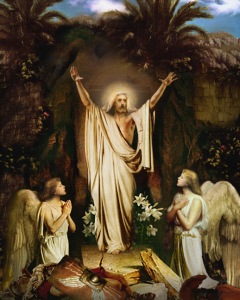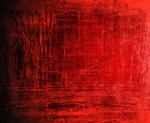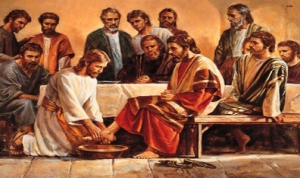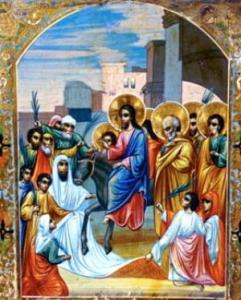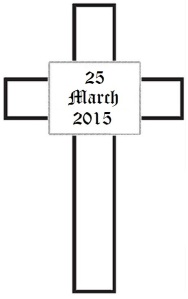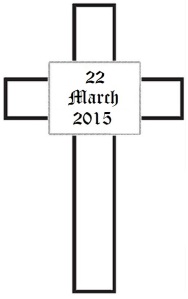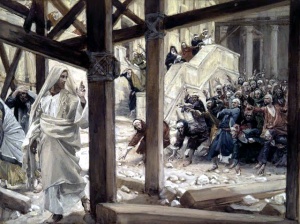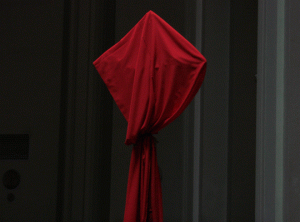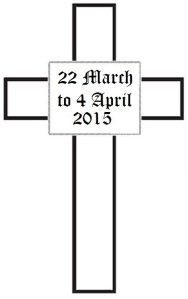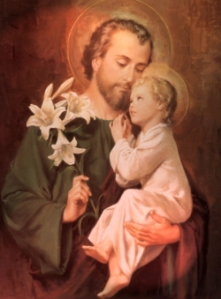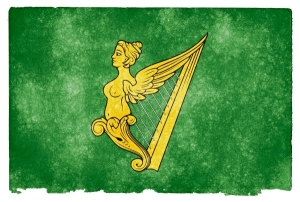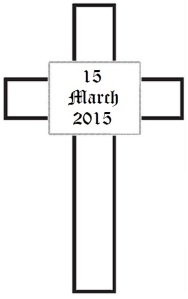Von Trapp Follow-Along: Maria talks about Good Friday and Holy Saturday in “HOLY WEEK” under “PASSIONTIDE” and about Easter Sunday under “PASCHALTIDE” in her book. She goes into quite a bit of detail about each day in the Easter Triduum. Naturally, Easter Sunday gets what is possibly the longest discussion of any day in her book, which is not surprising considering that Easter Sunday commemorates the most important and most foundational event in Christianity.
INTRODUCTION
The Easter Triduum encompasses Good Friday (beginning the evening prior, i.e., Holy Thursday evening), Holy Saturday, and Easter Sunday (until sunset). As such, it commemorates Christ’s passion, death, burial, and resurrection.
 COLOR
COLOR
The Easter Triduum used to be considered its own liturgical season but no longer is, so there is no one color for the entire Triduum. In the evening service on Holy Thursday, the color may be the white of Easter, the scarlet of Passiontide, or white and gold, depending on the denomination. On Good Friday, the liturgical color may be none, red, black, or black followed by violet. On Holy Saturday, there is technically no liturgical color because there is traditionally no service, though the Easter Night service held on the night of Holy Saturday may encompass black and/or violet. On Easter Sunday, the liturgical color is white, often with gold. The white liturgical color then continues throughout Eastertide.
 SYMBOL
SYMBOL
There are many symbols for the Easter Triduum. The symbol for Good Friday is the cross or crucifix because this is the day on which Christians commemorate Christ’s crucifixion. If there is a symbol for Holy Saturday, the only symbol I could find is the tomb, because Holy Saturday commemorates the day Jesus spent in the tomb. However, there are many symbols for Easter Sunday: Easter lilies are shaped like trumpets, and so are symbols of immortality (1 Corinthians 15:52); the butterfly’s life cycle is a symbol of eternal life, with the cocoon stage symbolizing burial and its emergence into a new and beautiful form symbolizing resurrection (1 Corinthians 15:53-54); eggs are symbols of fertility and immortality, and also the tomb from which Christ arose, with red eggs specifically symbolizing the resurrection (see Footnote 1); lights, candles, and bonfires symbolize the light of Christ; the cross, of course, symbolizes Jesus’ crucifixion and resurrection; and the lamb symbolizes Jesus, who was the Lamb of God, the sacrificial lamb to pay the price for our sins (1 Corinthians 5:7). Other symbols of Easter include the lion (Jesus is “the Lion of Judah” [Revelation 5:5]), the whale (Jesus said He would be buried for three days and three nights the same as Jonah was in the belly of the whale for three days and three nights [Matthew 12:40; Jonah 1:17, 2:10]), and the sand dollar. According to the American Bible Society, “The markings on this shell [the sand dollar] symbolize components of Christ’s birth and death. The five-point outline on the front of the sand dollar represents the star of Bethlehem (Matthew 2:1,2). The five holes in the sand dollar represent the pierced hands, feet, and side of Christ (Psalm 22:16; John 20:26,27). When the sand dollar is opened, it reveals five tiny objects that look similar to flying doves. Doves symbolize the Holy Spirit (Luke 3:21,22).”
 WHEN IS IT?
WHEN IS IT?
Because the Easter Triduum includes Good Friday (beginning the evening prior, i.e., Holy Thursday), Holy Saturday, and Easter Sunday, the Easter Triduum starts on the Thursday evening prior to Easter Sunday, or, three days before Easter Sunday. Therefore, the Easter Triduum may begin as early as 19 March (when Easter Sunday falls 22 March) or as late as 22 April (when Easter Sunday falls 25 April). This year, Easter Sunday falls 5 April, so the Easter Triduum begins at sunset on 2 April (Holy Thursday) and ends at sunset on 5 April (Easter Sunday).
WHAT IS IT?
The Easter Triduum, known since at least the second century as Pascha (Greek transliteration of the Hebrew word meaning “Passover”), was once a tiny liturgical season sandwiched between the liturgical seasons of Lent and Easter and which consisted of Good Friday, Holy Saturday, and Easter Sunday. It’s still a term appropriately applied to those three days, but it’s no longer considered a separate liturgical season. Previously, I wrote about how the church bells must be silent from Holy Thursday until the Easter service. The tradition is that the same is true in the home. For example, any bell rung to bring people to dinner is silenced and alternatives are found for calling people to eat.
Much in relation to Easter is referred to as “Paschal.” I read one online forum about Easter wherein an apparently poorly-informed atheist claimed Easter obviously wasn’t originally a Christian holiday but rather a co-opted pagan holiday because of the name “Pascha.” I wonder what he thought the word means to have given him such a conclusion. As it happens, “pascha” comes from the Greek “pascha,” which is a transliteration of the Hebrew word “pesach,” which means “Passover.” Recall that Jesus died on the Passover. See my previous post on co-opted pagan holidays for more information.
 4/2: Holy Thursday
4/2: Holy Thursday
Because we commemorate Jesus’ crucifixion on Good Friday, and because His arrest occurred—and therefore the process of His trials and crucifixion began—the night before, the evening of Holy Thursday begins the Easter Triduum. In reality, Jesus’ Last Supper and arrest would have occurred on Tuesday (see my previous blog post for more information). (Also, see Footnote 2 for the brief explanation.) Otherwise, I discussed Holy Thursday in detail in my previous blog post on Holy Week, so refer back to that post for more information on Holy Thursday.
On the evening of Holy Thursday, it’s traditional for Christians to celebrate the Passover Seder. (Coincidentally, this year, the true Passover—14 Nisan on the Hebrew calendar—falls on Good Friday!) It was tradition in Christ’s day, when a good friend or family member was to depart the following morning, for those remaining behind to toast the soon-to-be-departed with wine and unleavened bread, with the breaking of the bread symbolizing their love for the departing one. This tradition, which started among Christians with Jesus’ own great farewell in the Passover Seder He celebrated with His disciples the night before He died, was adopted by early Christians, who called it an “agape” or “love [feast].”
 4/3: Good Friday
4/3: Good Friday
Good Friday is also known as Holy Friday, Great Friday, and Black Friday. It is also sometimes known as Easter Friday, but this term technically refers to the Friday in Easter Week.
Good Friday commemorates Jesus’ crucifixion, death, and burial. In reality, this would have occurred on Wednesday and Jesus would have been in the tomb already on Friday (see my previous blog post for more information).
The Good Friday service sees the altar, bare since the Holy Thursday service, redressed (in black) and the sanctuary decorations, removed on Holy Thursday, return. This is considered fitting since it was on the cross that Jesus remade creation. The congregation, shoeless, walks down the church aisle, prostrating three times along the way, to the crucifix, where they kiss the feet of the crucified. When all the congregation has finished, the crucifix is placed on the altar and the congregation takes the Lord’s Supper. At the end of the service, the altar is again stripped.
Traditionally, the people fast on this day, though the fasting observed appears to vary by locale. In reality, the disciples may very well have fasted on the day Jesus died due to the approaching Sabbath and the probable lack of preparation for it while watching to see what would happen to their Rabbi. Talking is restricted to the bare minimum and is hushed, as it would be if a dearly beloved were dying or already dead in the home. From noon to 3 pm, the hours Christ spent on the cross (which in reality was 9 am to 3 pm; see my previous post on that topic), all activity in the house ceases and these hours are given to prayer, meditation, and spiritual reading with the occasional hymn sung. Furthermore, at about 3 pm, the hour of Jesus’ death, the vigil lamp (or “vigil light”) kept on the family altar is put out in honor of the death of the Light of the World.
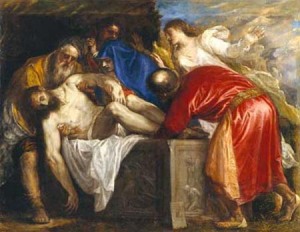 4/4: Holy Saturday or Black Saturday
4/4: Holy Saturday or Black Saturday
Holy Saturday commemorates the day Jesus spent in the tomb. In reality, He would have spent three days and three nights in the tomb (see my previous blog post on that topic).
On the morning of Holy Saturday, the paschal eggs (or, Easter eggs) are dyed and decorated. Maria Von Trapp tells that in her family, the children would take their dyed eggs to their rooms to decorate in secret, and many prepare a special Easter egg for someone else. The eggs are preserved until Easter Sunday morning, when they are eaten for breakfast. Most of the activity of Holy Saturday is merely preparation for Easter Sunday. Around 150 AD, a Christian writer identified that some Christians fasted for only one day, others for more, even up to forty days, and this may be the origin of the 40-day Lenten fast. As early as the 200s AD, the strict Easter Vigil fast ended after sundown on Holy Saturday, though by 313 AD, this fast was officially observed specifically by catechumens (new converts) about to be baptized (as they frequently were baptized during the Easter Vigil), and in the 400s AD, it was officially extended into a church-wide 40-day partial fast now known as Lent. Some today observe a partial version of this original Easter Vigil fast on Good Friday and not at all on Holy Saturday.
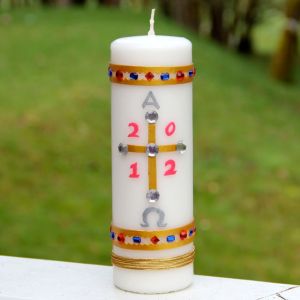 Recall that the church altar is stripped at the end of the Good Friday service. Normally, there is no morning service for Holy Saturday; hence, there is no liturgical color for this day. On Holy Saturday night, however, the Easter Night service begins. (The tradition of an Easter Night service was removed at some point and then later reinstated.) The “Feast of Light” occurs outside the church, where a bonfire is lit. The priest takes the Paschal candle and uses a knife to carve into it a cross, alpha, omega, and the current year. During the carving, he says, “Christ yesterday and today / the Beginning and the End / Alpha and Omega / His are the times and ages / To Him be glory and dominion / Through all ages of eternity / Amen.” Then the priest fixes five grains of incense in the cross on the candle, saying, “By His holy and glorious wounds / may he guard and preserve us / Christ the Lord. / Amen.” (Recall that Jesus was pierced with nails through His wrists and feet and by a spear through His side; hence, five piercings/wounds.) Finally, a separate candle is lit from the bonfire, and from this the priest lights the Paschal candle, saying, “May the light of Christ / In glory rising again, / Dispel the darkness of / Heart and mind.” The people then enter the church. At the threshold of the church, the priest/pastor and all the congregation lights their candles from the Paschal candle. Afterward, the service starts with singing. The priest/pastor, first dressed in Lenten violet, change into Easter white. After the service is over, each family lights a lantern from the Easter light (the bonfire) and takes it home to relight the family vigil lamp. Traditionally, families also take home blackened logs from the Easter fire and keep them at the fireplace to ward off danger from storms and lightning.
Recall that the church altar is stripped at the end of the Good Friday service. Normally, there is no morning service for Holy Saturday; hence, there is no liturgical color for this day. On Holy Saturday night, however, the Easter Night service begins. (The tradition of an Easter Night service was removed at some point and then later reinstated.) The “Feast of Light” occurs outside the church, where a bonfire is lit. The priest takes the Paschal candle and uses a knife to carve into it a cross, alpha, omega, and the current year. During the carving, he says, “Christ yesterday and today / the Beginning and the End / Alpha and Omega / His are the times and ages / To Him be glory and dominion / Through all ages of eternity / Amen.” Then the priest fixes five grains of incense in the cross on the candle, saying, “By His holy and glorious wounds / may he guard and preserve us / Christ the Lord. / Amen.” (Recall that Jesus was pierced with nails through His wrists and feet and by a spear through His side; hence, five piercings/wounds.) Finally, a separate candle is lit from the bonfire, and from this the priest lights the Paschal candle, saying, “May the light of Christ / In glory rising again, / Dispel the darkness of / Heart and mind.” The people then enter the church. At the threshold of the church, the priest/pastor and all the congregation lights their candles from the Paschal candle. Afterward, the service starts with singing. The priest/pastor, first dressed in Lenten violet, change into Easter white. After the service is over, each family lights a lantern from the Easter light (the bonfire) and takes it home to relight the family vigil lamp. Traditionally, families also take home blackened logs from the Easter fire and keep them at the fireplace to ward off danger from storms and lightning.
4/5: Easter Sunday
As discussed before, Easter Sunday will be presented in its own separate blog post.
Side Note: Technically, the Easter Night service, which begins at about 11 pm on Holy Saturday in some churches, crosses over midnight into Easter Sunday!
 LOOKING AHEAD
LOOKING AHEAD
Easter Sunday marks the beginning of Eastertide or Easter Season, a 50-day liturgical season. Holy Saturday, therefore, is the last day of Lent and Passiontide.
STANDARD ACTIVITIES
There are many traditional activities for this mini-season.
- Readings: The readings for this event are:
- Thursday: see my previous post for this
- Friday: Isaiah 52:13-53:12; Psalm 22; Hebrews 10:16-25; John 18:1-19:42
- Saturday: Job 14:1-14; Psalm 31:1-4, 15-16; I Peter 4:1-8; Matthew 27:57-66
- Sunday: see my next post for this
- Passover Seder. Traditionally, Christians celebrate it on Thursday evening, the day Jesus was traditionally considered to have celebrated it with His disciples. In reality, He would have celebrated it on Tuesday evening. Furthermore, the real date for the Passover this year (2015) is Good Friday. Consider celebrating the Passover Seder this year.
- Good Friday. There are several activities for this day.
- Décor: Good Friday’s color is usually black but may also be red or none.
- Fasting: Normally, the Lenten diet ends on Holy Thursday, but Christians traditionally fasted again on Good Friday, perhaps in memory of Jesus’ implicit command to His disciples to fast when the Bridegroom (Himself) was taken from them (Matthew 9:14-15; Mark 2:18-20).
- Vigil: During the hours Jesus was on the cross (9 am to 3 pm, though traditionally 12 noon to 3 pm is used instead), activity ceases, people speak only if necessary and then only in hushed voices (as they would if a loved one was actively dying in the house), and the time is given to prayer, meditation, and singing of hymns.
- Vigil Light: The candle on the family altar or in the chapel that represents Jesus is allowed to burn all day until 3 pm, the hour of Jesus’ death, at which time it is put out.
- Good Friday Service: Consider attending a Good Friday church service.
- Holy Saturday. There are several activities for this day.
- Décor: Technically, Holy Saturday has no liturgical color, but they may use black in the Easter Night service.
- Paschal Eggs: The eggs to be eaten on Easter Sunday are cooked and decorated today.
- Fasting: The Easter Vigil fast which begins on Friday ends on Saturday evening.
- Holy Saturday Service: Consider attending an Easter Night church service.
KNIT AND CROCHET ACTIVITIES
The Easter Triduum commemorates Jesus’ trials, passion, crucifixion, death, and burial. Consider working something very simple on this day: a cross.
- Knitting Patterns: “Cross of Unity” by Melanie Schaab (here). (NOTE: Make just the cross, not the hoops.)
- Crochet Patterns: “Christian Cross” by Suzanne Alise” (here). Note: I found information on the size of the cross, which measures 4” x 6.25” when finished, so much larger than I intended since all ornaments should be approximately 3” at the largest measurement (length/width/diameter), so you may have to adjust the number of stitches to get the appropriate size.
じゃあまたね!
FOOTNOTES
Footnote 1: Easter eggs and other symbols. Because Easter will be in another blog post of its own, I don’t want to go into too much detail here, but I wanted to briefly address the concern that certain Easter symbols are pagan in origin. Briefly, it’s true that some are and were probably intentionally co-opted, while others are pagan symbols but the connection to Easter is probably coincidental because both happen to occur in the spring, and still others are probably purely Christian. I’ll try to go into detail on each symbol in that post.
Footnote 2: The brief explanation. The brief explanation is that we know Jesus died on a Sabbath, and that the weekly Sabbath occurs on Saturday (beginning at sunset the evening prior, i.e., Friday); therefore, the church has traditionally held that Jesus must have died on a Friday a few hours before the Sabbath started at sunset. However, there are several additional Sabbaths throughout the year tied to a specific date rather than to a day of the week, and these Sabbaths, called “high Sabbaths,” most often fall during the week. One such Sabbath is the first day of the Feast of Unleavened Bread, which starts at sunset on the day after the Passover, and we know Jesus celebrated the Passover the evening before He died, so we know the following sunset (a few hours after His death) would have been a high Sabbath. In other words, because the Passover began at sunset the evening before Jesus died, we know that He died before a Sabbath (specifically, a “high Sabbath”) no matter what day of the week He died. Other evidence from Scripture—such as His prophecy that He would be in the tomb three days and three nights; facts regarding when He traveled to Bethany, and from Bethany to Jerusalem; and the use of the plural “Sabbaths” in the original Greek in the Gospel of Luke telling that Mary came to the tomb after the “Sabbaths”—demonstrate that there were two Sabbaths during Jesus’ entombment, one of which was the high Sabbath of the Feast of Unleavened Bread, and the other of which was the weekly Sabbath on Saturday. Again, see my previous blog post for more details.

